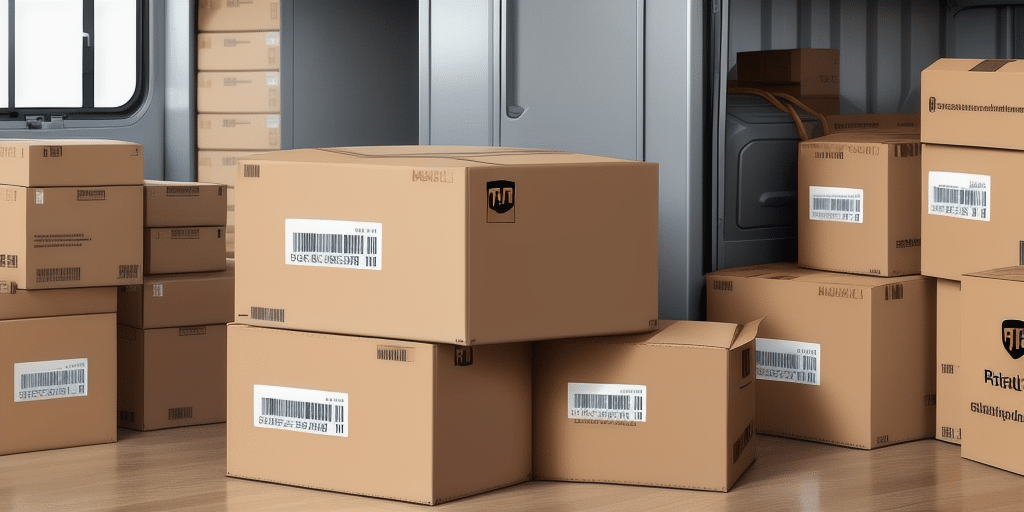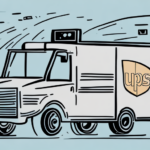Why E-Commerce Shipping Labels Are Important for Logistics
E-commerce shipping labels are essential for logistics as they serve as a critical reference for all parties involved in the shipment process. These labels contain detailed information about both the sender and receiver, including addresses, tracking numbers, and other vital details. By utilizing these labels, e-commerce businesses can streamline their logistics operations, minimize errors, and reduce the likelihood of lost or damaged packages.
According to Statista, global e-commerce sales are projected to reach $6.4 trillion by 2024, highlighting the increasing importance of efficient shipping processes. Additionally, e-commerce shipping labels play a crucial role in ensuring compliance with shipping regulations and customs requirements. These labels often include information about the package's contents, such as the type of product, weight, and value. This information is necessary for customs officials to determine the appropriate duties and taxes to be levied on the shipment. Without accurate shipping labels, e-commerce businesses may face delays, fines, or even legal consequences.
The Benefits of Creating and Printing E-Commerce Shipping Labels
Creating and printing e-commerce shipping labels offers numerous benefits, including:
- Improved Accuracy and Speed: Automated label creation reduces human error and accelerates the shipping process.
- Reduced Risk of Package Loss and Damage: Clear and accurate labels ensure packages are handled correctly throughout the delivery process.
- Enhanced Communication: Labels provide essential information to all parties involved, facilitating better coordination.
- Efficient Use of Resources: Streamlined label printing saves time and resources for e-commerce business owners.
Moreover, creating and printing e-commerce shipping labels can help businesses save on shipping costs. By leveraging online shipping platforms, businesses can compare rates from different carriers and choose the most cost-effective option for each shipment. This can lead to significant savings over time, especially for businesses that handle large volumes of orders.
What Information Should Be Included in an E-Commerce Shipping Label?
When creating an e-commerce shipping label, it's crucial to include several key pieces of information:
- Sender's Name and Address: Ensures the package can be returned if delivery fails.
- Receiver's Name and Address: Accurate delivery information is essential for timely receipt.
- Date of Shipment: Helps track when the package was sent.
- Package Weight and Dimensions: Necessary for calculating shipping costs and ensuring proper handling.
- Tracking Number: Allows both sender and receiver to monitor the package's progress.
Additionally, include the shipping method and any special instructions for the carrier, such as "fragile" or "perishable." For international shipments, it's important to declare the value of the contents to comply with customs regulations and accurately assess duties and taxes.
Step-by-Step Guide to Creating and Printing E-Commerce Shipping Labels
Creating and printing e-commerce shipping labels is a straightforward process. Follow these steps to get started:
- Choose a Shipping Label Template: Select a template that meets your needs. Many e-commerce platforms like Shopify and Magento offer built-in templates, or you can design one using graphic design software like Adobe Illustrator.
- Enter Necessary Information: Input the sender and receiver's details, tracking number, and any other required information.
- Select the Right Printer and Label Material: Choose a printer and label material that suit your needs. Thermal printers are popular among e-commerce businesses for their speed and cost-effectiveness.
- Print the Label: Print the label and securely attach it to your package, ensuring it is clearly visible.
- Record Tracking Information: Enter the tracking number and relevant details into your e-commerce platform or shipping software to monitor the package's progress.
Be aware that different shipping carriers may have specific requirements for their labels, such as font size or tracking number placement. Always verify with your chosen carrier to ensure your label meets their standards to avoid delays or shipment issues.
Choosing the Right Printer and Label Material for Your Needs
Selecting the appropriate printer and label material is crucial for producing professional and reliable e-commerce shipping labels. Popular printing options include:
- Laser Printers: Suitable for high-volume printing with sharp text quality.
- Inkjet Printers: Ideal for low to medium volumes but may require more maintenance.
- Thermal Printers: Preferred for their speed, cost-effectiveness, and durability.
Common label materials include matte and glossy paper, clear plastic, and adhesive-backed thermal paper. When selecting a printer, consider the volume of labels you'll be printing. For small businesses with low volume needs, an inkjet printer may suffice. However, larger businesses with high volume requirements might benefit more from a thermal printer, which can handle large quantities efficiently.
Additionally, consider the environment in which the labels will be used. For instance, if your products are exposed to moisture or extreme temperatures during shipping, choose a label material that can withstand these conditions. Clear plastic labels are suitable for moisture-prone environments, while thermal paper labels are ideal for extreme temperature conditions.
Tips for Designing Eye-Catching E-Commerce Shipping Labels
While functionality is paramount, the visual appeal of your shipping labels can enhance your brand's presence. Here are some tips for designing eye-catching labels:
- Incorporate Brand Elements: Use your logo and brand colors to make your package easily recognizable.
- Include Visual Graphics: Add appealing graphics or images to attract attention.
- Use Clear Fonts: Choose easy-to-read fonts to ensure all information is legible.
- Prominent Information Display: Ensure all essential details are clearly visible and well-organized.
Consider the size and shape of your label to ensure it fits your package appropriately without obscuring critical information. Unique label shapes, such as circles or triangles, can help your package stand out, but always verify with your shipping carrier to ensure compliance with their requirements.
Common Mistakes to Avoid When Creating and Printing E-Commerce Shipping Labels
While the process is straightforward, certain mistakes can hinder the effectiveness of your shipping labels:
- Incorrect or Incomplete Addresses: Always double-check addresses to prevent delivery failures.
- Mistaken or Missing Tracking Numbers: Ensure tracking numbers are accurately entered and included.
- Choosing the Wrong Printer or Label Material: Select equipment and materials that align with your volume and environment needs.
- Illegible Fonts or Missing Information: Use clear fonts and include all necessary details to avoid confusion.
Additionally, failing to accurately measure and weigh packages can result in incorrect shipping rates and delays. Always verify package dimensions and weight before creating labels. Proper packaging is also essential to prevent damage during transit, which can compromise label visibility and integrity.
How to Save Time and Money with Automated Label Printing Solutions
Automated label printing solutions can significantly enhance your logistics operations by saving time and reducing errors. These systems automate the creation and printing of shipping labels, allowing for:
- Efficiency: Quickly generate labels for multiple shipments without manual input.
- Accuracy: Minimize human error through automated data entry.
- Scalability: Easily manage increasing shipment volumes as your business grows.
Additionally, many automated solutions offer integration with various shipping carriers and e-commerce platforms, enabling seamless management of multiple shipments and real-time tracking. This automation allows businesses to focus more on growth and customer satisfaction rather than administrative tasks.
Integrating E-Commerce Platforms with Your Shipping Label Software
For e-commerce businesses operating across multiple platforms, integrating your e-commerce platform with shipping label software can streamline logistics operations. By connecting your e-commerce platform with your shipping label software, you can:
- Automate Label Creation: Generate shipping labels directly from your platform without manual data entry.
- Reduce Data Errors: Minimize mistakes by syncing data between systems automatically.
- Enhance Tracking: Easily monitor the progress of shipments within your platform.
Integration simplifies the shipping process, ensuring that order information flows seamlessly between your sales channels and logistics management tools. This connectivity enhances efficiency, accuracy, and overall operational effectiveness.
Best Practices for Managing and Tracking Your Shipment Orders
Effective management and tracking of shipment orders are vital for maintaining smooth logistics operations. Implement the following best practices:
- Comprehensive Record-Keeping: Track all essential information, including package weight, dimensions, and tracking numbers.
- Regular Status Checks: Monitor the status of your shipments and promptly inform customers of any delays or issues.
- Utilize Shipping Software: Adopt shipping software that integrates with your e-commerce platform for streamlined operations.
- Organized Packaging Materials: Keep packaging supplies organized and accessible to expedite the packing process.
Implementing these practices ensures that shipments are handled efficiently, customers are kept informed, and potential issues are addressed proactively, enhancing overall customer satisfaction.
Addressing Common Issues with Shipping Labels: Lost, Damaged, or Incorrectly Printed
Despite careful preparation, issues with shipping labels can still arise, such as lost, damaged, or incorrectly printed labels. To mitigate these problems:
- Maintain Printer Quality: Ensure your label printer is in good working condition and replace worn-out components as needed.
- Use High-Quality Materials: Opt for durable label materials that withstand handling and transit conditions.
- Double-Check Information: Verify all details before printing to prevent errors.
- Record Tracking Numbers Promptly: Enter tracking information immediately to reduce the risk of lost packages.
Implementing these measures can significantly reduce the occurrence of label-related issues, ensuring smooth and reliable delivery processes.
How to Improve Your Customer Experience with Branded Shipping Labels
Branded shipping labels can enhance the customer experience by providing a memorable unboxing moment. By prominently featuring your logo and brand colors on shipping labels, you can:
- Increase Brand Recognition: Make your brand easily identifiable, fostering customer loyalty.
- Enhance Perceived Value: Presenting a professional and cohesive brand image can elevate customers' perception of your business.
- Differentiate from Competitors: Unique and branded labels can make your packages stand out in a crowded market.
Additionally, branded shipping labels contribute to a consistent brand experience, reinforcing customer trust and encouraging repeat business.
Future Trends in E-Commerce Shipping Technologies and Labeling Solutions
The e-commerce shipping and logistics landscape is continually evolving, with emerging technologies shaping future trends. Key trends to watch include:
- Augmented Reality-Enabled Shipping Labels: Interactive labels that provide additional information or promotional content via AR.
- Smart Packaging: Packaging equipped with sensors to monitor conditions and provide real-time data on package status.
- Blockchain-Powered Tracking: Enhanced transparency and security in logistics operations through blockchain technology.
- Further Platform Integration: Deeper integration between e-commerce platforms and shipping software for seamless operations.
Staying abreast of these trends can help e-commerce businesses adopt innovative solutions, improve logistics efficiency, and provide superior customer experiences.
Conclusion
Creating and printing e-commerce shipping labels is a fundamental aspect of logistics for any e-commerce business. By following the guidelines and best practices outlined in this article, you can produce professional labels that enhance the efficiency and accuracy of your shipping operations. Whether aiming to save time and money, ensure compliance, or elevate the customer experience, well-designed shipping labels are indispensable for success in the competitive e-commerce landscape.






















